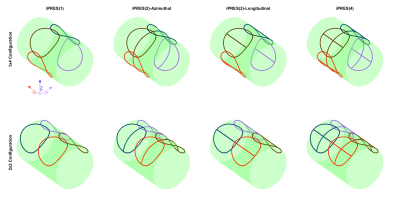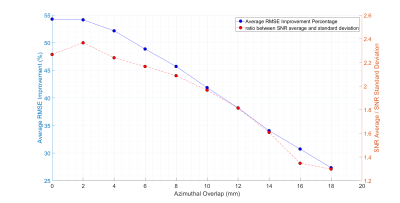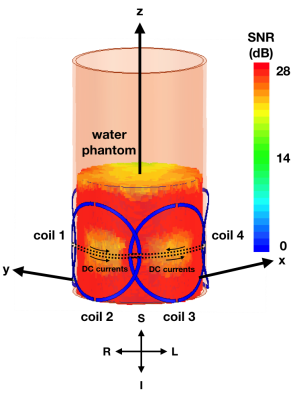4230
Numerical optimization of an iPRES coil design for high SNR and localized B0 shimming performance in small animal imaging1Medical Physics Graduate Program, Duke University, Durham, NC, United States, 2Brain Imaging and Analysis Center, Duke University, Durham, NC, United States, 3Biomedical Magnetic Resonance Laboratory, Washington University in St. Louis, St. Louis, MO, United States, 4School of Biological and Health Systems Engineering, Arizona State University, Tempe, AZ, United States
Synopsis
Susceptibility-induced B0 inhomogeneities can cause distortions and signal loss, which are exacerbated in small animal imaging due to the typically higher field strength and smaller anatomy. Here, we further develop the integrated parallel reception, excitation, and shimming (iPRES) coil technology, which enables imaging and localized B0 shimming with a single RF/shim coil array, for small animal imaging. We start by numerically optimizing the design of a 4-channel iPRES rat coil array to achieve both a high B0 shimming performance (54.2% reduction in B0 root-mean-square error) and a high and uniform SNR over the brain.
Introduction
Susceptibility differences at air/tissues interfaces create localized B0 inhomogeneities, causing image artifacts such as distortions and signal loss in applications like functional MRI and diffusion-weighted imaging. These effects are exacerbated in small animal preclinical imaging compared to human imaging because of the smaller anatomy and typically much higher field strength. Conventional spherical harmonic shim coils cannot effectively shim localized B0 inhomogeneities, because they are often limited to a low order due to cost and space restrictions within the scanner bore.Multi-coil shimming with localized shim coil arrays placed closer to the human1, mouse2, or rat3 brain is more effective, but such arrays compete with the RF coils for space around the subject. In contrast, the integrated parallel reception, excitation, and shimming (iPRES) coil design allows RF and DC currents to flow on the same coil elements, enabling imaging and localized B0 shimming with a single RF/shim coil array, while maintaining a high shimming performance, as shown in the human brain4–6 and spinal cord7,8. The iPRES(N) coil design splits each RF coil element into N smaller shim loops with independent DC currents, allowing a more effective shimming of localized B0 inhomogeneities in the human abdomen9 and breast10.
Here, we further develop the iPRES technology for small animal imaging and start by performing B0 shimming and SNR simulations to optimize the coil design to achieve both a high B0 homogeneity and a high and uniform SNR.
Methods
MRI acquisition: A B0 map of a healthy in vivo Sprague Dawley rat brain was acquired on a 4.7T small animal MRI scanner (Agilent Technologies) after 2nd-order spherical harmonic shimming using a multi-echo gradient-echo sequence with TR = 352 ms, TEs = 1.6-13 ms (8 equal steps), FOV = 6x6 cm, matrix size = 128x128, slice thickness = 1 mm, 24 slices. The experiment was approved by the Washington University IACUC.B0 shimming simulations (in Matlab): Different coil arrays were modeled, consisting of four iPRES(1), iPRES(2), or iPRES(4) coil elements (30-mm diameter) wrapped in a 1x4 or 2x2 layout around a cylinder (40-mm diameter), with different overlaps between adjacent coil elements (0-20 mm) in the azimuthal and/or longitudinal directions (Figure 1). For each model, the Biot-Savart law was used to generate 4, 8, or 16 basis B0 maps representing the magnetic fields generated by a DC current of 1 A separately applied to each iPRES(1) coil element or iPRES(N) shim loop.
A shim optimization was performed to determine the DC currents that minimize the root-mean-square error (RMSE) between the rat’s baseline B0 map scaled to 7T and a combination of the basis B0 maps within a brain mask. Whole-brain and slice-optimized shimming were performed, using a DC current limit of 0.2, 0.4, or 0.6 A.
SNR simulations (in ANSYS HFSS): Electromagnetic simulations of the iPRES coil array were performed to determine the SNR average and standard deviation over a cylindrical water phantom for the coil configurations and overlaps used in the B0 shimming simulations. The coil elements were tuned to be similar for each simulation by adjusting their RF-matching components in a circuit simulator, which eliminated tuning-related changes in SNR.
Results and Discussion
Slice-optimized shimming with the 1x4 iPRES(2)-Azimuthal or 1x4 iPRES(4) coil designs was much more effective than slice-optimized shimming with the other six coil designs or whole-brain shimming with any coil design (Figure 2), for different coil overlaps and DC current limits. The 1x4 iPRES(4) coil design only slightly outperformed the 1x4 iPRES(2)-Azimuthal coil design and was thus not deemed worth implementing, considering the added complexity due to the small space available in 30-mm coil elements.For slice-optimized shimming with the 1x4 iPRES(2)-Azimuthal coil design, the B0 RMSE improvement was maximal at an overlap of 0 mm (with the coil elements’ edges touching), was nearly identical at an overlap of 2 mm, and then declined with increasing overlaps (Figure 3). Similarly, the ratio between the SNR average and standard deviation peaked at an overlap of 2 mm. Thus, an optimal overlap of 2 mm was chosen to achieve both a high B0 shimming performance and a high and uniform SNR (Figure 4).
For slice-optimized shimming with the 1x4 iPRES(2)-Azimuthal coil design, decreasing the DC current limit from 0.4 to 0.2 A reduced the B0 shimming performance by 19.8%, whereas increasing the current limit to 0.6 A only slightly increased it by 1.4%. Considering the lower availability of small components with higher current ratings, an optimal current limit of ~0.4 A may be more practical, while still providing a high B0 shimming performance.
Slice-optimized shimming with 48-channel multi-coil arrays in the mouse2 or rat3 brain reduced the B0 standard deviation by 62% and 72%, respectively. The proposed 4-channel iPRES(2) rat coil design (which only has 8 shim loops) has a slightly lower shimming performance (54.2%, which may be improved with further optimization), but, importantly, enables imaging and localized B0 shimming with a single RF/shim coil array.
Conclusion
A 4-channel iPRES(N) rat coil design was numerically optimized to achieve a high B0 shimming performance and a high and uniform SNR. The optimal coil array will be implemented to experimentally demonstrate the advantages of the iPRES technology for small animal imaging.Acknowledgements
This work was in part supported by grants K01 DK109119, R21 EB024121, R01 NS075017, and R01 EB028644 from the National Institutes of Health, GE Healthcare, and the Duke-Coulter Translational Partnership.References
[1] Juchem C, Nixon TW, McIntyre S, Boer VO, Rothman DL, de Graaf RA. Dynamic multi-coil shimming of the human brain at 7 T. J Magn Reson. 2011;212(2):280-8.
[2] Juchem C, Brown PB, Nixon TW, McIntyre S, Rothman DL, de Graaf RA. Multicoil shimming of the mouse brain. Magn Reson Med. 2011;66(3):893-900.
[3] Juchem C, Harman P, Sanganahalli BG, Brown PB, McIntyre S, Nixon TW, Green D, Hyder F, de Graaf RA. Dynamic Multi-Coil Technique (DYNAMITE) Shimming of the Rat Brain at 11.7 Tesla. NMR Biomed. 2014;27(8):897-906.
[4] Truong TK, Darnell D, Song AW. Integrated RF/shim coil array for parallel reception and localized B0 shimming in the human brain. NeuroImage 2014;103:235-240.
[5] Stockmann J, Witzel T, Keil B, Polimeni JR, Mareyam A, LaPierre C, Setsompop K, Wald LL. A 32-channel combined RF and B0 shim array for 3T brain imaging. Magn Reson Med. 2016;75(1):441-451.
[6] Wiley D, Darnell D, Song AW, Truong TK. Application of Integrated Parallel Reception, Excitation, and Shimming (iPRES) for Signal Loss Recovery in fMRI. ISMRM 2018; 0838.
[7] Topfer R, Foias A, Lopez Rios N, Chauffray A, Germain G, Arango N, Wald L, Stockmann J, Cohen-Adad J. Integrated B0/Rx coil array for improved spinal cord imaging at 3T. ISMRM 2018; 0834.
[8] Cuthbertson J, Darnell D, Stormont R, Robb F, Song AW, Truong TK. A 4-Channel iPRES-W AIR Coil Array for Simultaneous MR image Acquisition and Wirelessly-Controlled Localized B0 Shimming of the Spinal Cord. ISMRM 2019; 1489.
[9] Darnell D, Truong TK, Song AW. Integrated parallel reception, excitation, and shimming (iPRES) with multiple shim loops per radio-frequency coil element for improved B0 shimming. Magn Reson Med. 2017;77(5):2077-2086.
[10] Ma Y, Darnell D, Zhang H, Robb FJ, Song AW, Truong TK. Integrated Parallel Reception, Excitation, and Shimming (iPRES) Breast Coil Array for Simultaneous MR Image Acquisition and Localized B0 Shimming. ISMRM 2018; 0842.
Figures



